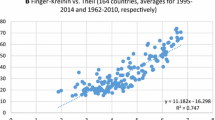Abstract
This paper examines the implications of the Heckscher-Ohlin (HO) Model for the patterns of production and trade that will emerge as a country grows. It focuses primarily on world equilibria that include two or more cones of diversification. Starting with the textbook model of two factors and two goods, growth paths for production and trade are derived in terms of a country's capital-labor ratio relative to that of the world. With additional goods and countries, multiple cones create a ladder of comparative advantage that a country will climb as it accumulates capital relative to the world. With additional factors as well, more complicated patterns can emerge. In a three-factor model based on Krueger (1977), a country with fixed land, growing labor, and faster growing capital can first work its way down the ladder of comparative advantage before climbing back up. Using a graphical representation due to Leamer (1987) of a more general three-factor model, cones of diversification with large numbers of goods take the form of polygons that a growing country may pass through, then cross between. In all cases, the lesson of the HO Model is that growth causes repeated and extreme changes in patterns of specialization and trade over time.
Similar content being viewed by others
REFERENCES
Davis, Donald R. and David E. Weinstein (1999), ‘Trade in a Non-integrated World: Insights from a Factor Content Study,’ in process, (April 29).
Deardorff, Alan V. (1974), ‘A Geometry of Growth and Trade,’ Canadian Journal of Economics, 7, (May), pp. 295-306.
Deardorff, Alan V. (1979), ‘Weak Links in the Chain of Comparative Advantage,’ Journal of International Economics, 9, (May), pp. 197-209.
Deardorff, Alan V. (1984), ‘An Exposition and Exploration of Krueger's Trade Model,’ Canadian Journal of Economics, 17, (November), pp. 731-746.
Deardorff, Alan V. (1994), ‘The Possibility of Factor Price Equalization, Revisited,’ Journal of International Economics, 36, pp. 167-175.
Deardorff, Alan V. (1997), ‘Rich and Poor Countries in Neoclassical Trade and Growth,’ Research Seminar in International Economics Discussion Paper No. 402, University of Michigan, June 29.
Deardorff, Alan V. (1998a), ‘Determinants of Bilateral Trade: Does Gravity Work in a Neoclassical World?,’ in: Jeffrey Frankel (ed.), The Regionalization of the World Economy, Chicago, University of Chicago Press.
Deardorff, Alan V. (1998b), ‘Does Growth Encourage Factor Price Equalization,’ Discussion Paper No. 431, Research Seminar in International Economics, University of Michigan, August 10.
Debaere, Peter and Ufuk Demiroglu (1998), ‘On the Similarity of Country Endowments and Factor Price Equalization,’ in: Peter Debaere, The Factor Proportions Theory of International Trade and Finance, PhD thesis, University of Michigan, chapter 2.
Findlay, R. and H. Grubert (1959), ‘Factor Intensities, Technological Progress and the Terms of Trade,’ Oxford Economic Papers 11, pp. 111-121.
Galor, Oded (1996), ‘Convergence? Inferences from Theoretical Models,’ Economic Journal, 106, (July), pp. 1056-1069.
Jones, Ronald W. (1971), ‘A Three-Factor Model in Theory, Trade, and History,’ in: J.N. Bhagwati, R.W. Jones, R.A. Mundell, and J. Vanek (eds.), Trade, Balance of Payments, and Growth: Essays in Honor of Charles P. Kindleberger, Amsterdam, North-Holland.
Krueger, Anne O. (1977), Growth, Distortions, and Patterns of Trade Among Countries, Princeton Studies in International Finance, No. 40, (Princeton).
Leamer, Edward E. (1987), ‘Paths of Development in the Three-Factor, n-Good General Equilibrium Model,’ Journal of Political Economy, 95, pp. 961-999.
Rybczynski, T. M. (1955), ‘Factor Endowments and Relative Commodity Prices,’ Economica 22, pp. 336-341.
Solow, Robert (1956), ‘A Contribution to the Theory of Economic Growth,’ Quarterly Journal of Economics 70, pp. 65-94.
Author information
Authors and Affiliations
Rights and permissions
About this article
Cite this article
Deardorff, A.V. Patterns of Trade and Growth across Cones. De Economist 148, 141–166 (2000). https://doi.org/10.1023/A:1004096611584
Issue Date:
DOI: https://doi.org/10.1023/A:1004096611584




